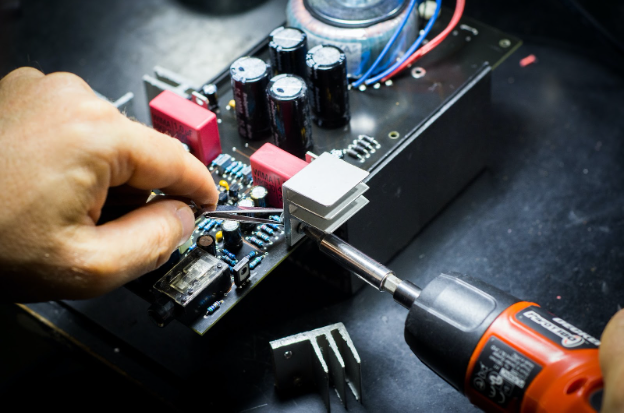Five Steps for Optimizing Your Electronics Manufacturing Production Planning

By Eric Whitley

Eric Whitley
The importance of production planning can’t be stressed enough. It’s not just a logistical exercise; it’s the strategic core of your entire operation. A well-executed plan can be your competitive edge, ensuring that your resources, both human and material, are utilized to their fullest potential.
The problem lies in various inefficiencies and bottlenecks within the production process, such as machine malfunctions and inventory mismanagement. They’re not just operational hiccups — they’re profit killers. Whether it’s a machine breakdown that halts production or a poorly managed inventory that leads to overstocking, these issues can cost you dearly.
The first step is to recognize these issues as systemic problems instead of isolated incidents, and then address them at the root level.
Using lean manufacturing concepts and industry best practices, this guide offers actionable steps to optimize your production planning. Each step is backed by proven strategies and technologies that can transform your electronics manufacturing operations from the ground up. Let’s dig in!
Step 1: Assess Your Current Production Process
Begin by conducting a thorough analysis of your existing workflows. Use advanced process mining tools that can integrate with your ERP and MES systems to provide real-time analytics, potentially on all workflows in the end-to-end production process. These tools can identify patterns and anomalies in machine performance, inventory levels, and supplier interactions that might not be apparent through manual observation.
Beyond software tools, consider bringing in external experts for a comprehensive audit. These professionals can offer a fresh perspective and may identify issues that internal teams fail to notice. Pair this external viewpoint with data analytics for a 360-degree assessment of your entire production process, from raw materials to finished goods.
After mapping out your workflows, zero in on the bottlenecks and inefficiencies. These could range from machine downtimes to supplier delays or even internal communication breakdowns. The key is to identify these issues at the granular level so you can formulate targeted solutions.
Step 2: Set Clear Objectives and Involve Stakeholders
Your objectives should be laser-focused and tied to measurable outcomes. For instance, if cost reduction is a goal, specify the percentage reduction you aim to achieve within a set timeframe. These quantifiable objectives serve as the foundation for your entire production optimization strategy.
Setting SMART goals is another necessity for success. Each goal should be distilled into its SMART components — Specific, Measurable, Achievable, Relevant, and Time-bound — ensuring that it’s not just a wish but a clearly defined target. This level of detail provides a clear path for execution and accountability.
One great tip is to engage your suppliers and customers early and often. Use structured feedback loops, such as regular review meetings or digital collaboration platforms, to keep them involved in production planning. Their input can offer invaluable insights into market demands and logistical challenges, helping you fine-tune your plans.
Step 3: Choose the Right Technology
Automation is no longer a luxury. It’s a requirement for staying competitive. From automated material handling systems to AI-driven quality control, technology can revolutionize every facet of your production process. The key is to choose solutions that can scale and adapt to changing manufacturing conditions.
When selecting ERP or MES systems, look for platforms that offer modular solutions. This allows you to implement functionalities as needed, reducing upfront costs and enabling a more agile deployment. Ensure that the software can integrate not just with your existing systems but also with those of your suppliers and customers.
Finally, IoT devices and sensors can function as your eyes and ears on the shop floor. Opt for devices that offer real-time data transmission and built-in analytics capabilities. This enables not just monitoring but also predictive maintenance, reducing unplanned downtime.
Step 4: Implement a Pilot Program
Test your project on a smaller scale with a pilot program. Choose a product line or a specific production cell where you can implement changes without disrupting your entire operation. This focused approach allows for more accurate data collection and makes it easier to isolate variables.
During the pilot phase, your data collection should be exhaustive. This includes not just machine performance data but also human factors like operator efficiency and job satisfaction. Analyze this data in conjunction with feedback from floor managers and operators to assess the pilot’s success.
Based on the pilot results, be prepared to go back to the drawing board. Whether it’s tweaking machine settings or revising your supplier contracts, these adjustments are crucial for the success of full-scale implementation. Document these changes meticulously, as they’ll serve as valuable case studies for future optimization efforts.
Step 5: Monitor, Adjust, Scale, and Optimize
Your Key Performance Indicators (KPIs) are the strategic performance measurements that align with your business goals. Make your KPIs visible to all stakeholders, from shop floor operators to C-level executives, and you’ll foster a culture of accountability and continuous improvement.
With advanced monitoring tools, you can make adjustments in real time. This could be as simple as rerouting materials to alleviate a bottleneck or as complex as dynamically adjusting machine parameters to optimize performance. The key is to act swiftly, minimizing the impact of any disruptions.
Production planning optimization is not a one-off project but an ongoing initiative. As your business grows, your optimization strategies should scale proportionally. Invest in modular solutions and foster a culture of continuous improvement to ensure that your production planning remains agile and efficient.
Key Takeaways
If you’ve read this far, you’re equipped with a framework for optimizing your production planning. You’ve learned how to conduct a comprehensive assessment, set actionable goals, leverage the right technology, and implement and scale your solutions.
Take these insights back to your team, initiate a dialogue, and start implementing these changes. Remember that optimizing your plant is a continuous journey that calls for regular adjustments and informed leadership throughout the process.
For over 30 years, Eric Whitley has been a noteworthy leader in the Manufacturing space. In addition to the many publications and articles Eric has written on various manufacturing topics, you may know him from his efforts leading the Total Productive Maintenance effort at Autoliv ASP or from his involvement in the Management Certification programs at The Ohio State University, where he served as an adjunct faculty member.
After an extensive career as a reliability and business improvement consultant, Eric joined L2L, where he currently serves as the Director of Smart Manufacturing. His role in this position is to help clients learn and implement L2L’s pragmatic and simple approach to corporate digital transformation.
Eric lives with his wife of 35 years in Northern Utah. When Eric is not working, he can usually be found on the water with a fishing rod in his hands.












